the art of don hill (continued)

Of Shore of Sand’ Don Hill 2022
I have always had an interest in the environment and it's make up, or if you like what's happening to it as time progresses. The road that led me to this place Nudgee Beach was totally accidental and unexpected as well as never planned.
Originally an unwelcome journey it became the ending of one and the beginning of another that eventually led to a fresher start in life but at that time doubt had set in. This led me to find a wealth of man made Flotsam that makes this place home on occasions so I made a conscious note of its location for future reference and moved on.
The beach at Nudgee is quite different to what people expect to see of a beach especially in Australia as it provides a sanctuary for wildlife, mangroves and indigenous flowering plants.
Even though at that time it was awash with detritus it didn’t appear to make a visual impact on the population of wild inhabitants.
Seagrass grows everywhere and provides beautiful cover for the timid aquatic species and a hunting ground for the Ibis and Egrets.
There is an abundance of soldier crab burrows and barnacle colonies as well as lovely oysters.
The thing that was lacking at Nudgee Beach was surf.
Don't bring a board here as you will be disappointed.
Later on I became interested in using items that were available from renewable and free resources such as I had seen there. A compulsion.
A new discovery.
 Bamboo Assemblage, early 2000's Sold Private Collection
Bamboo Assemblage, early 2000's Sold Private Collection Cut Green Bamboo Assemblage, early 2000's
Cut Green Bamboo Assemblage, early 2000'sDiscovering Bamboo
I had an interest with and including natural occurring materials that could be recycled as well as the rejected and also living and growing things that had to be cut back from time to time. This is how my interest in Bamboo began and still continues today at which time I would ask friends if they new of locations where they had seen clumps of culms in the Brisbane area being trimmed or collected by Council Workers. Prior to this I would drive to locations where I knew there
were clumps growing and wait for the council harvest to happen. Eventually I got to know some of the arborists and they would contact me when a cut was about to happen.
At that time bamboo was a scarce commodity.
The cuttings produced a hard substrate on which to apply acrylic paint and gold leaf, becoming the main medium and evident in most of the later works that were never seen by the general public in Australia and now only surviving as a photo record here as most pieces were purchased and shipped to Europe.
All of the works from this time rely on a spontaneity and lack of thought about composition.
This is how they had come about.
Without thought. Without regulation.
Rely on what is inside you not a visual perception.
I would collect cut and dry the substrate so this was possibly the only part that required active planning.
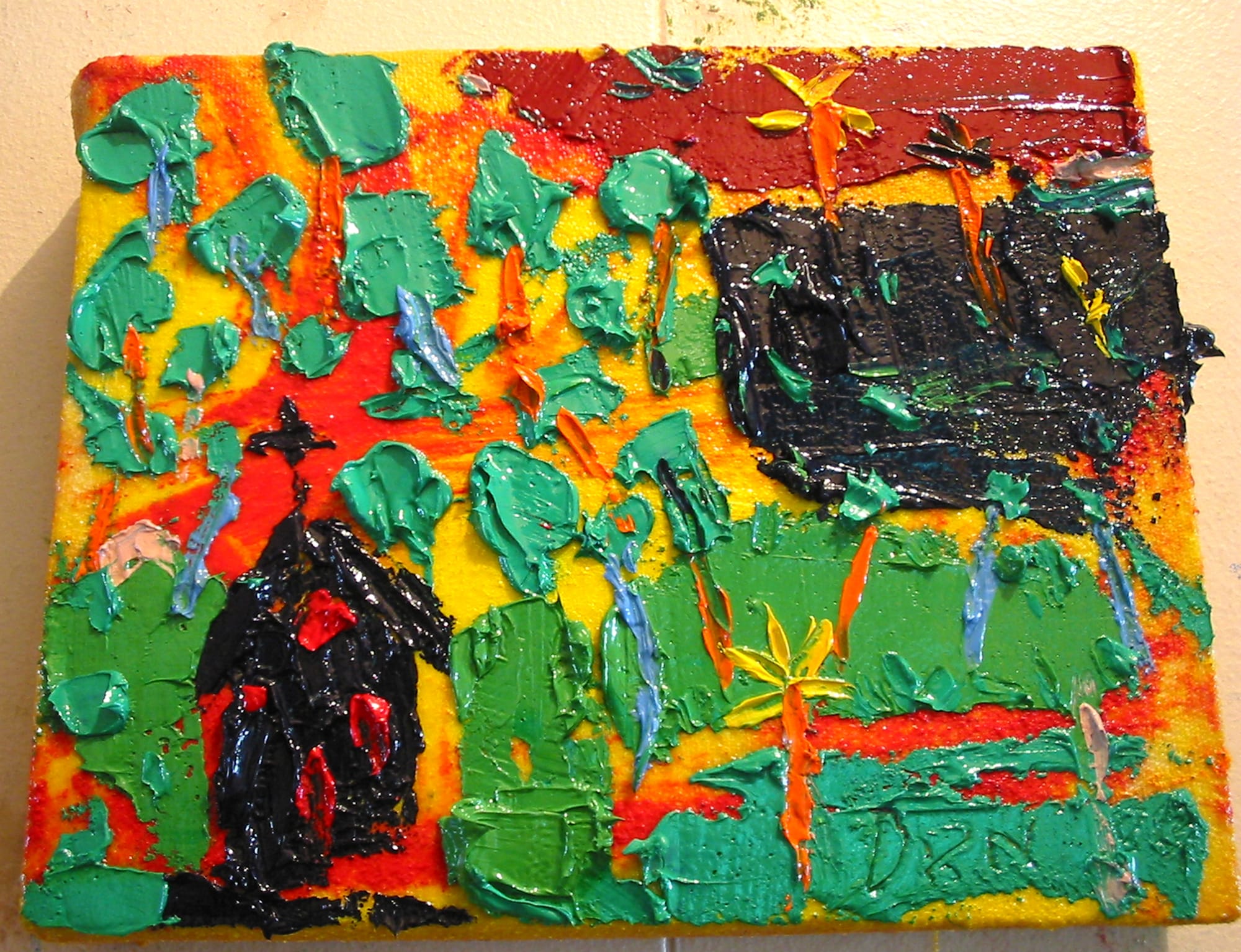 Dark Feluga Chapel Oil Paint on Canvas 2006, 2007 Sold Private Collection Melbourne The Paintings from Nature
Dark Feluga Chapel Oil Paint on Canvas 2006, 2007 Sold Private Collection Melbourne The Paintings from Nature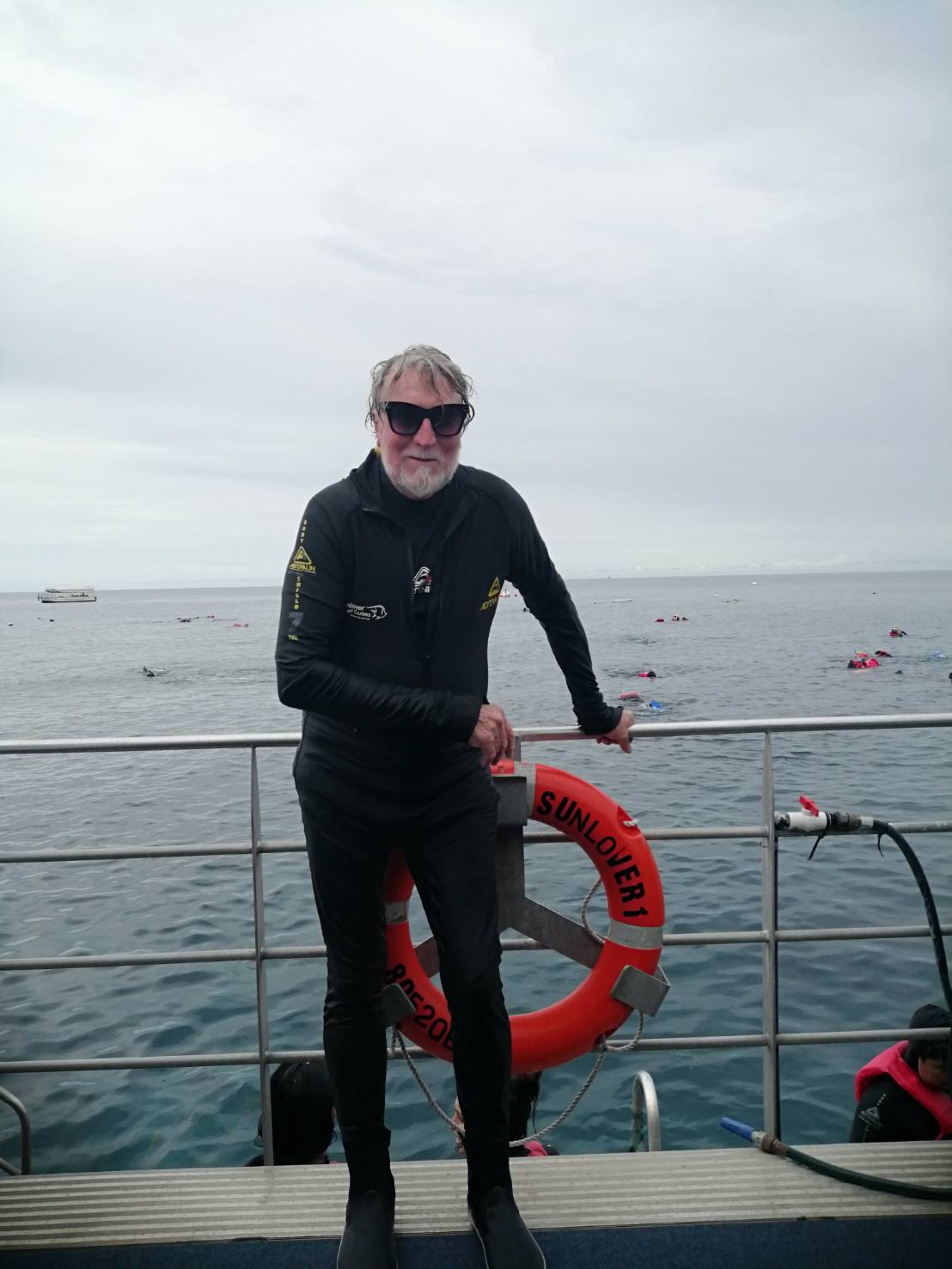 About Composition
About CompositionYears earlier when I was out on location with Frank De Silva he would carry a matboard frame to dissect the landscape and by placing certain structures in different parts of his canvas and paste board he would assemble a composition. In his later works this practice disappeared and his finished oils became more delicate and took on a mystic form compared to the regulated captures of his past. Being mentored by well known artists who followed particular rules on composition formula I came to the understanding this did not apply to me as composition comes naturally and should not be sought to complete a work of art as such. In fact I thought it was boring that this was the main instrument that should be sought in pursuing a completed piece.
It becomes a bit like having to have tuition with Bob Ross.
The practice of not determining composition and becoming more involved in the past or present experiences as well as process to pursue an outcome becomes more relevant. Your aesthetic wherever it comes from does not matter to you or anyone else. Its just you.
Working close also helps.
When I lived in Europe and London in the 1970's I was inspired by the impressionists and their idea of working up close.
This lends credence to active thinking about and absence of thought about composition.
Patches of colour would replicate light and replace form to give the works a living momentum.
This was the motivation for me to study this process more.
Further with this, some of the individual pieces I had became toned down and I left areas unpainted as to spare the necessity of total coverage and display the substrate. The substrate needs to be known. An awareness of source and beginning.
Its bare skin becomes part of the art.
After all composition and colour are individual and I used this ideology to hide some of the things that happened to me on the journey that the bamboo pieces depict.
Apart from that, colour would create an interest and engagement among the viewers even though the main collection of bamboo compositions would never be shown publicly in Australia.
 Bamboo Assemblage, early 2000's Private Collection Switzerland. Sold
Bamboo Assemblage, early 2000's Private Collection Switzerland. Sold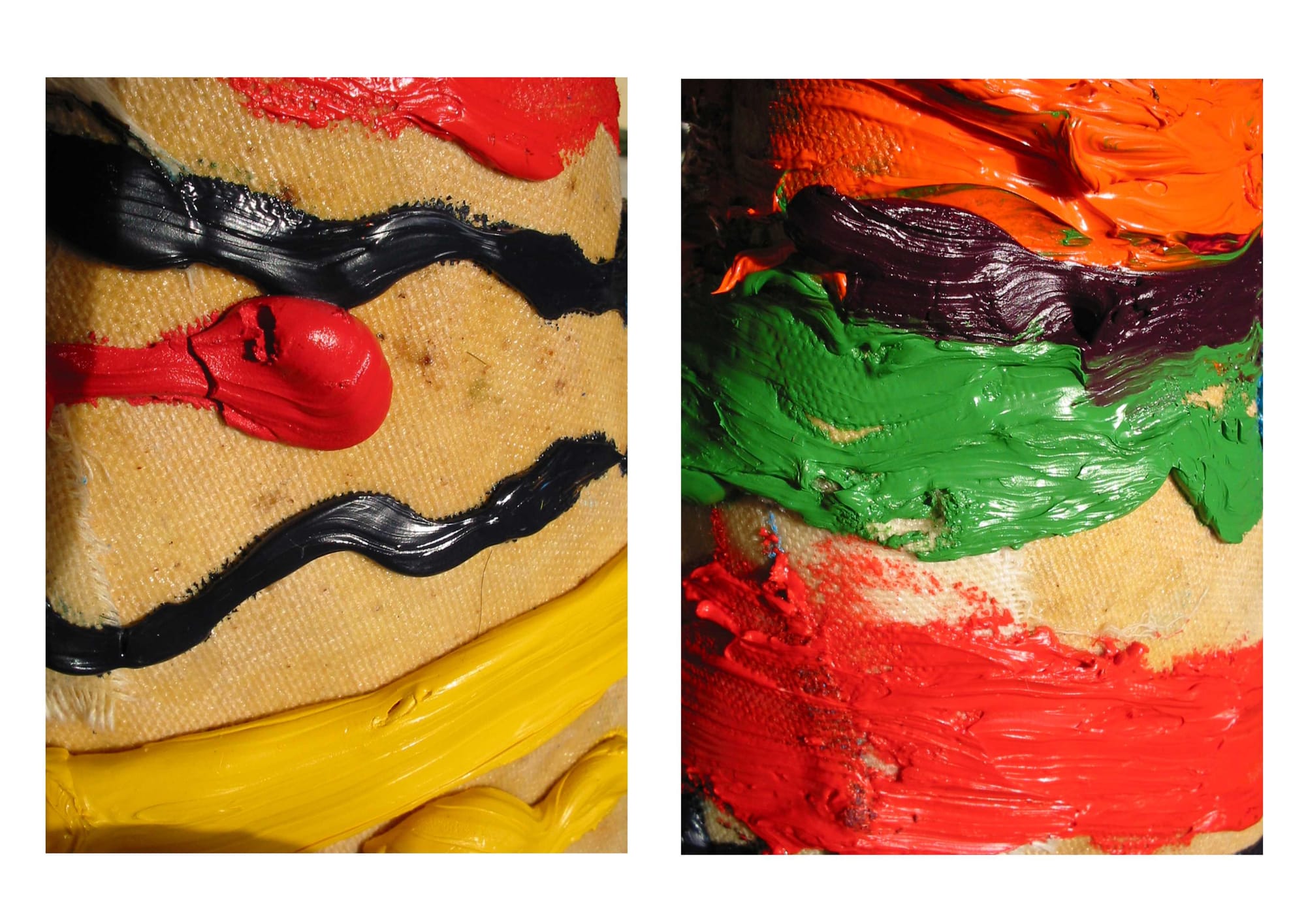 Night Life and Living at the Beach.
Night Life and Living at the Beach.When one looks at the bamboo pieces for a time they will start to notice things. Possibly faces, eyes, a nose and animals peering out from beyond the light and dark shadows that are contained in the works although they may seem welcoming at first there is a mood that may be encountered.
The more Friday Night intoxicated you are the more you will see in these works.
A figurative state or study possibly showing an Ibis and a scrub turkey scratching at the sand and mud. A Sand Crab clawing. Regardless that there may be something in the darkness in these compositions or the local possum and carpet snake looking out from them they invite the viewer to participate further in their muse and nonsense.
This is the indecision and regulation of Nature.
Not obvious at first glance or until viewed at a distance.
It may seem strange that anyone can use bamboo to produce art but this became part of my demure and was not sought out to make a statement. It just happened.
A Non Objective accident.
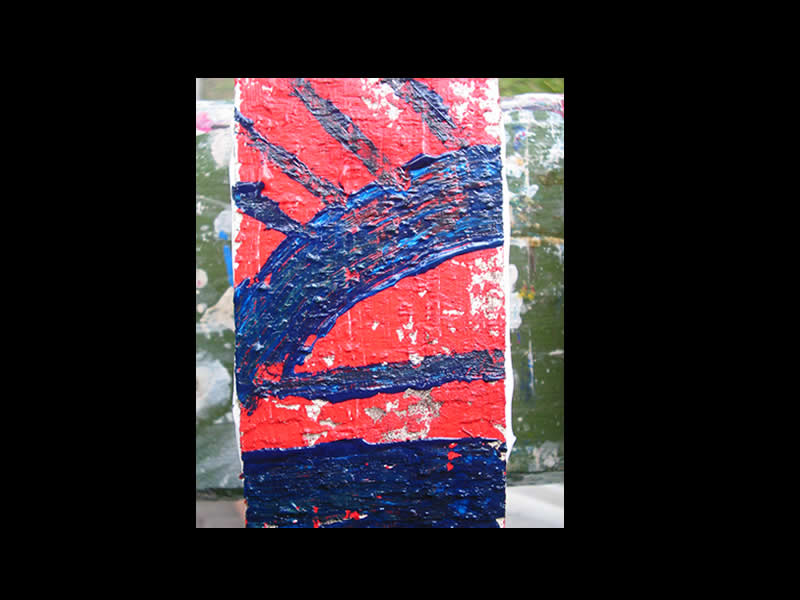 Liberty 911. Hero of the Beach assemblage 2004
Liberty 911. Hero of the Beach assemblage 2004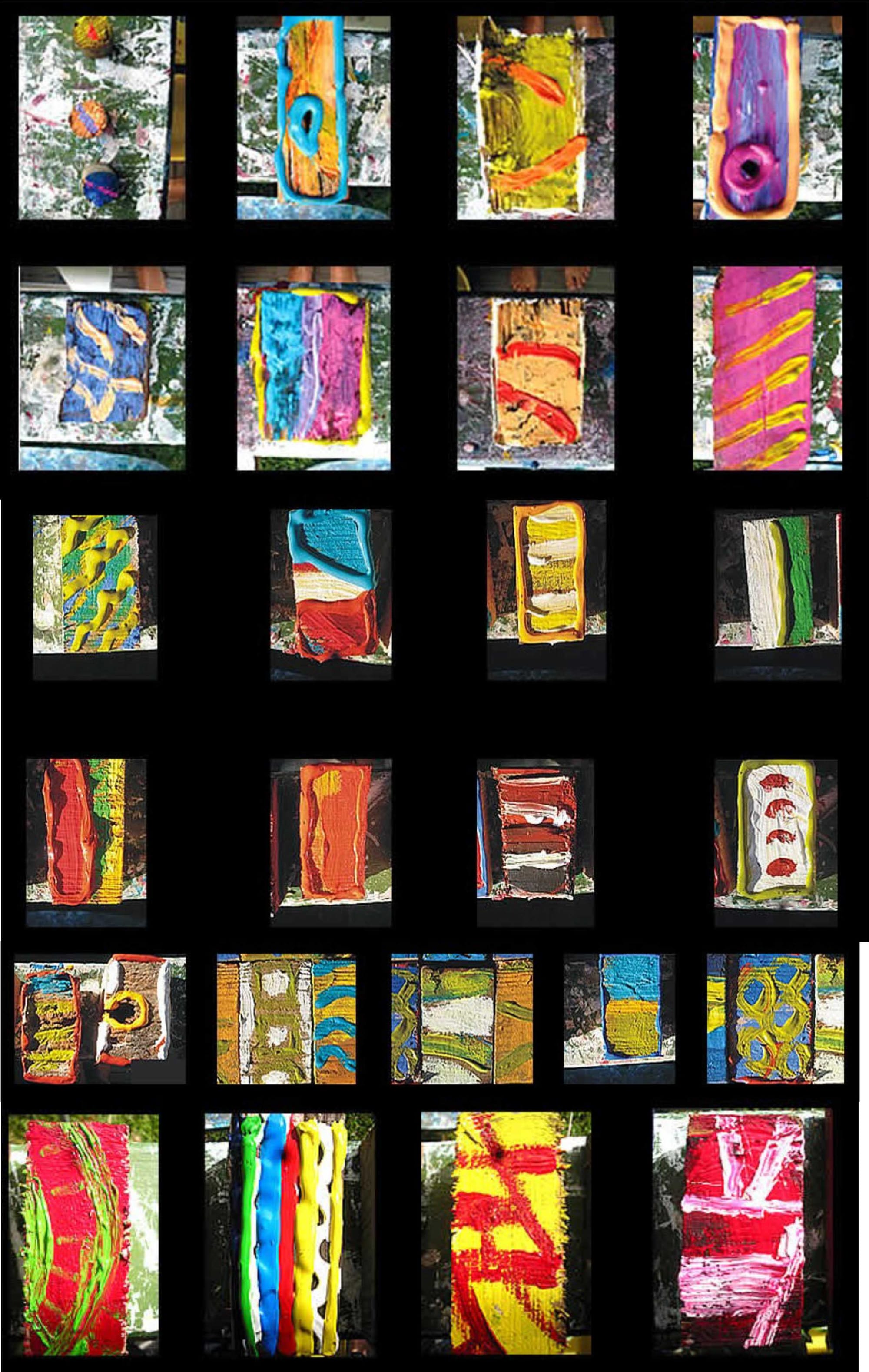 Assembling Bits of Wood.
Assembling Bits of Wood.Later on wood assemblages were painted freely with acrylic paint as well as over and underlaid with Gold Leaf. Each individual piece carefully picked and collected from Nudgee Beach in it's rough form, transported to the Brisbane Night Studio, washed and cleaned, sorted and assembled into initial arrangements and then left for some time to dry before proceeding any
further. I was very selective with this collection.
These became a further development to future works, their rough substrate becoming part of the composition.
They depict times that were more enjoyable and free with less fear in the air from the night, bugs and darkness.
A life change was coming in my story and once again a freedom that had been sort and was absent for some time.
The times started to change and I was able to make trips to the city and at times have conversations with Verlie even if they were brief and not remembered about myself and also what the Town Gallery was doing and representing.
Verlie was capable of holding an interesting conversation even though there may have been an odor of my rough living in the air.
The wood assemblages could be arranged at will and would become complete when they were arranged in a box made of found pallet wood and frames.
The fact that the works are housed in a framing substrate shows the absence or care for seeking convention.
The piece "Hero of the Beach' supports this.
The majority of works in those times from 2002 till 2006 had a three dimensional quality in that the viewer could not only involve and emerge themselves in the compositional interpretation but could see a further quality that most flat artworks did not exhibit and lacked.
This meant that the work could be seen as a sculpture or a painting.
I believe that rough and spontaneous support of any art is important and adds an integral facet to be interpreted and catch the attention of an audience but at no time take away the message that is being sort or sent by and about the artist or about the art itself.
Frank De Silva taught me this.
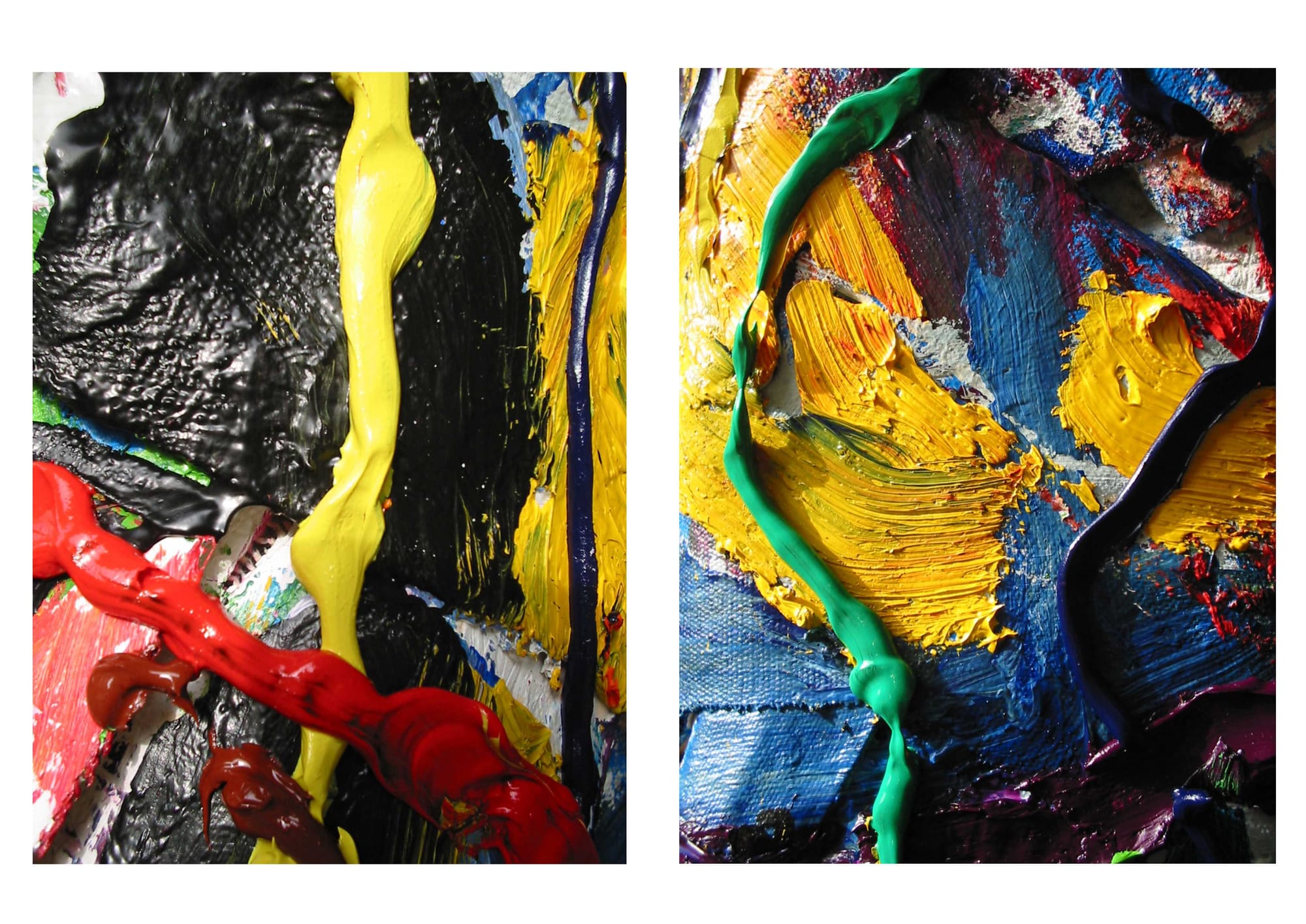 Compulsion
CompulsionFor the majority of pieces I have produced during my lifetime I have no explanation as to how or why I would have started them except the compulsion to do so. Maybe just to explain the human effect and my state.
My adventure or this adventure of life was about an absence or an equation of presence in the world of art a ‘Depth of Presence’ and 'Undercurrent' that may become an awareness of times gone past with my possible future. It was never a
quest for money.
Was never a journey to an perceived end for gain or any expectation to fulfill a quest so to speak except to produce these works as memories of my previous times and experiences.
Obvious influences in my works are derived from studying the works of artists like John Coburn.
His brightly coloured and sharply drafted shapes brought a new freshness to the landscape.
My first experience in seeing his work was in a movie with actor James Mason in the 1960's.
I have never sat down and made a drawing of what I am going to produce and may only see these compositions fleetingly in my mind .
To do this would become a treachery that invites disaster.
Drawing would be an attempt to produce a finished piece of art before it is actually undertaken in full and finished at will as being untrue to yourself and intentions.
Let your hands and true inner self produce the work not a pre conceived vision that becomes nothing on a worthless piece of paper.
A crosscut hand saw is handy and was my best sketching tool as well as using discarded rejected canvases, tubes of oil paint, acrylic and some alcohol to bring about inspiration about past memories of a lonely but full past life at the beach.
Written by Don Hill 2022
 Archival Photos courtesy of Australian Artist Brent Harvey
Archival Photos courtesy of Australian Artist Brent HarveyThe Art of Don Hill by Dr John Dahlsen
Upon viewing the works from this period, I was struck particularly by the works titled Night Crawl, Shorelines and Landscapes from the Rim. These individual series exemplifying a certain mature confidence and a positionality within an international context.
This time frame: 2002-2006, was around the time when Don created works around Transient Life as well as the Desert Beach. He says somewhere in the 1990's he became a wanderer with no fixed address or place of employment. Times were tough, it was in the middle of a recession. He found the best places to hang out were in coastal areas where there was occasional work and on occasion, free accommodation. Don said the beach and surrounds inspired him, although not at that time, into the creation of finished art.
The environment was harsh and thus began the collection of discarded items to produce things to help with survival, with some of the local beaches awash with pallets and other useful items, canvas, vinyl and timber for uprights and shelter. Pieces that were created later in the early 2000's, bear witness to this experience and his time spent in the Salt Wilderness. For Don, these pieces examine the day-to-day rambling of a transient life.
Don says it was evident that the bamboo compositions had a link to this period and is particularly evident in some of the creations especially
“Out on the Town", "Night at the Beach', "Sucking Neptune', "Sail', "Sickcada' and the wooden block piece "Hero of the Beach'. The multitude of experiences had by Don during this time brought about changes to the way he thought and revealed a way to move forward with manifesting these new creations.
Don has stated that there were external influences which contributed to this development as
well, with the he main instigator apparently being myself. He says this may have been indicative of a new movement and collaboration of like minds in the world of art.
Don feels that now with twenty years having passed from the origin of the first pieces of wood covered in canvas fabric, it is now the right time for this work and these thoughts to be written about, especially the bamboo compositions which started to appear in late 2004 and which were scarcely seen or were shipped overseas to Europe.
 Wood Assemblage early 2000's
Wood Assemblage early 2000's The Desert Beach works 2004 - 2006 Tripping in the Tropics. Private Collections
The Desert Beach works 2004 - 2006 Tripping in the Tropics. Private CollectionsThe Desert Beach works and Working with a Rejected Landscape:
In 2003, Don started experimenting with Stringer Frames. This came about because he had been interested in Building Boats an endeavor which never eventuated but was still in his mind as he had never been lost at sea. Just lost. He had an idea where this process could be used in his art and the "Rejected Landscapes" would eventually materialize. The stringers acted as support for the canvas and were attached to a central core of wood held together in a timber base of found pallet wood. Don says most of the material for these came from Nudgee Beach. They made quite a sturdy structure and could be made to almost any size required. This became a new view point of the world as just bare sculpture or works covered in oil paint, possibly depicting an undersea or rain forest environment.
These almost became an attraction to the artist himself.
He could embrace them in their own right or reject them as he had been.
Everything became rejected at that time.
Even him.
A new era had come and eventually it would pass by without being noticed by anyone.
Even the artist.
The exhibition at Cooloola Regional Gallery brought a new series to the public from the 'Shorelines" of discovery. The stringers in the works became a talking point in themselves and had an antique look that could be associated with aviation and flight or floating along on the waves of an Ocean. This exhibition would become the first appearance of the "Desert Beach Works' The viewer could take a journey through this interpretation of environment interacting and involving themselves in it. The Rejected Landscapes formed the basis of the exhibition.
The works shown were created in the early 2000's as conceptual, experimental pieces when Don worked in regional areas and travelled the regional gallery circuit. He states: "I loved this, as I owed it to my late contemporaries to undertake this journey". He said it was a great excuse to head out on the road for an upcoming show, meet and make new friends. He elaborated: "I used this time to develop my aesthetic into a meaningful form other than painting seascapes of my previous marine adventures. Most of my subjects are derived from this environment'.
The day after 911 Don made several sales through a Gallery in Brunswick Street Fortitude Valley. It seemed to him that people wanted something beautiful to cling to instead of the dreadful devastation of that time. He reminisced: "I remember selling several paintings on the day after 911. It was remarkable that people were still clinging to hope and beauty instead of disaster".
Don's exhibition at the Boonah Regional Art Gallery "Landscapes from the Rim" was met with a high engagement audience of locals and visitors alike. Don stated at the time "The great thing about showing in regional areas is that you can make an impact. Overall, some
individuals visited this exhibition more than three times to examine and comment on this show". The majority of pieces featured in this show, were derived from collecting from the abundance of found wood from local beaches. Don says: "There was an overwhelming abundance, whereas today it is more difficult to find and collect. Nudgee Beach became one of my favourite places as this material was everywhere. Once collected I would cut sections and cover them with canvas from any of the rejected landscapes".
Thus, they produced a paintable area, an interesting subject and talking point of past experiences for Don. He says: "This is how the exhibition 'Shorelines' came about and eventually was presented at the Cooloola Shire Public Gallery, as every piece was found and collected along the Shoreline, except of course the "Rejected Landscapes". At that time a full understanding of this concept seemed to take back-stage. The Gympie Times described the exhibition as being 'salacious'. This exhibition also had some of the more recent uprights which represented reefs in seas and mountains on land. 'Peter Dobe the Flautist, was kind enough to compose a contemporary piece of the same name, to compliment this exhibition.
Don states: "Following the exhibition I discovered bamboo which I could acquire
locally from parks and gardens as the council workers would cut the Culms and leave them on site for a few days before picking them up for disposal. This led to a new awakening. It was in 2004. My resistance to collecting this material was low and I would take trips around Brisbane hunting this material. Don continues: "I would cut sections of the culms into smaller pieces, this increased my interest in the media, as I could see forms and sculptures in my mind's eye and they were easy to work with. This started my use of acrylic paint, which I had not been so fond of in the past. I would paint each piece individually as a separate piece of art which would come together as a complete composite composition and each piece would become a sustainable piece of art". The following year Don entered one of the small bamboo sculptures into the Churchie Art Prize and was accepted as one of the finalists
I congratulate Don for this compilation of work from 2002-2006. We exhibited alongside each other in exhibitions at various intervals during this period. I believe there are brilliant glimpses in the collection of artworks from this period work and I'm pleased to have been invited by Don to write about his work and his journey as a contemporary artist for this publication.
 Dr John Dahlsen, Senior Lecturer Course Convenor of Creative Arts 2022
Dr John Dahlsen, Senior Lecturer Course Convenor of Creative Arts 2022 The Desert Beach works 2004 - 2006 Tripping in the Tropics. Private Collections
The Desert Beach works 2004 - 2006 Tripping in the Tropics. Private CollectionsThe “Desert Beach Works”
These works have a psychedelic quality and were constructed in the midst of late nights and
early morning sessions helped along by wine.
Being rejected landscapes they represented the recycling of previous works that did not fit with the idea of finished art.
So therefore “Rejected’.
Formed by placing canvas over stringer frames Don would staple and glue the waste canvas to the stringers in a similar fashion to using the "West System' of manufacture.
The surface would then be covered in a sizing solution to enable the works to last the test of time.
Once dry and hardened the surface made an ideal substrate for a painted finish.
"I tended to get carried away with the paint application and I would use the full content of tubes of oil paint to cover the surface of the works."
"An expensive process with stunning visual effects.’
“People looked at these indifferently and there was a possible hint in their eyes when they saw these pieces that something wasn't quite right with me and my artistic approach and that the treatment of a practitioner might have to be sought.’
“Was I brave enough to show them publicly?’
Overall it was a release from everyday life for Don and once created the works would be stored in his shed for an attempted drying.
The drying process was long and the works could not be shown immediately as they were oil paint.
They made their first appearance at the Cooloola Public Gallery in 2004.
The Gympie Times published details of the upcoming show and described the exhibition as salacious.
"It did not matter to me about general comment as the majority of the works prior to assembling were collected from the Shoreline of Moreton Bay before making their way to the Brisbane Night Studio for further processing.'
"I was grateful that the works finally attracted the attention of the general public and also to
Peter Dobe for his musical composition to compliment the show titled "Shorelines".
The bases of the “Desert Beach Works’ were made from Pallet Wood collected at Nudgee Beach and stored until required at some later date for Don to use.
To this day it is unclear if there were other substances involved in the production of the "The Desert Beach
Works". Maybe Rubber Cement.
Copyright Don Hill 2022